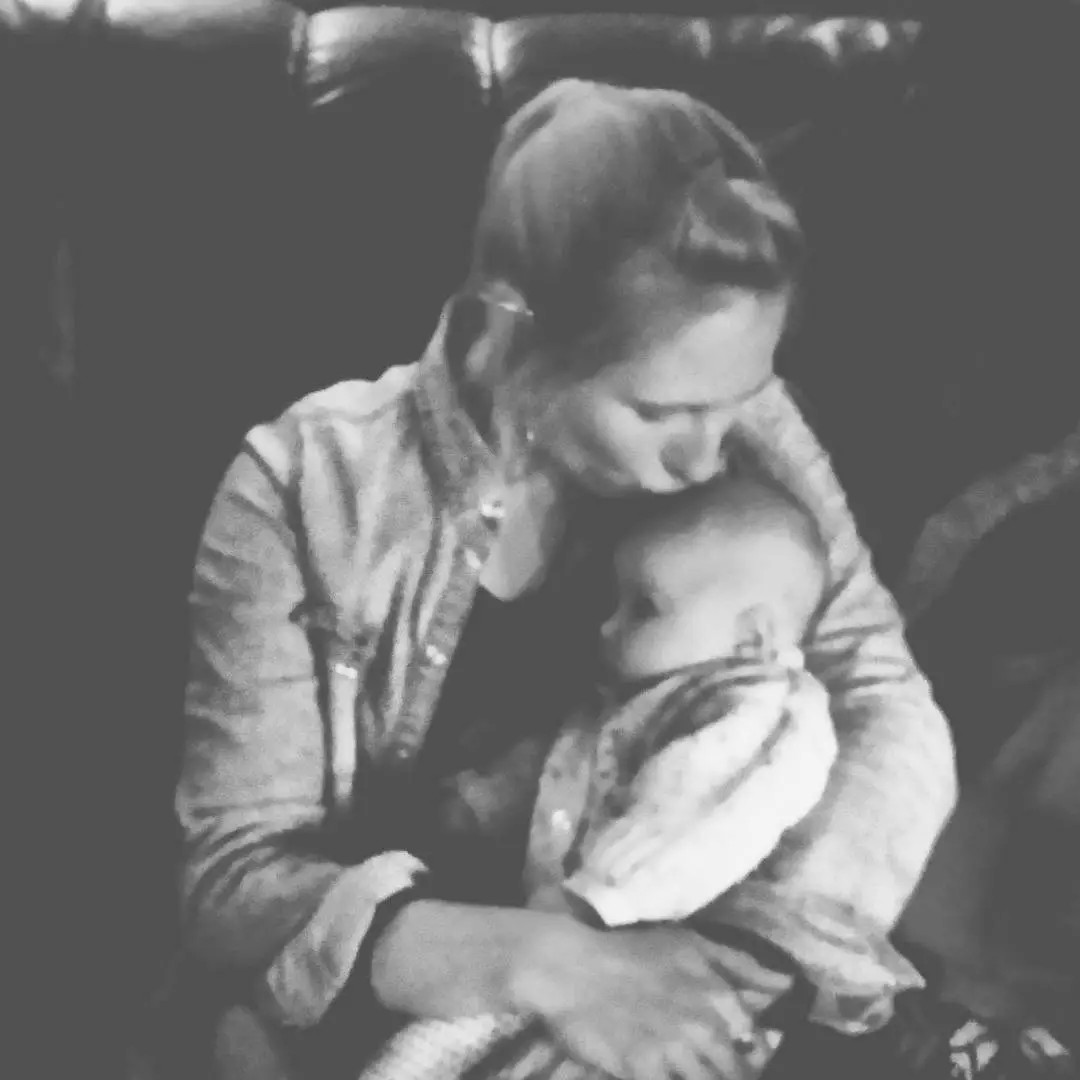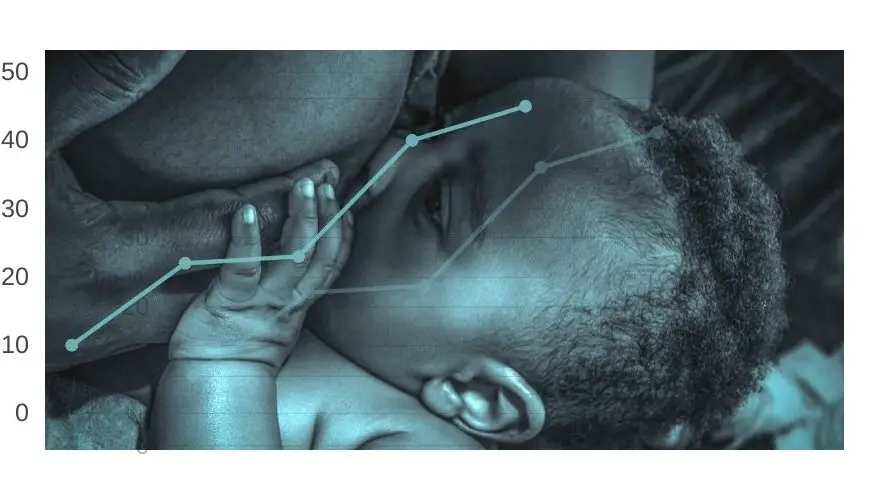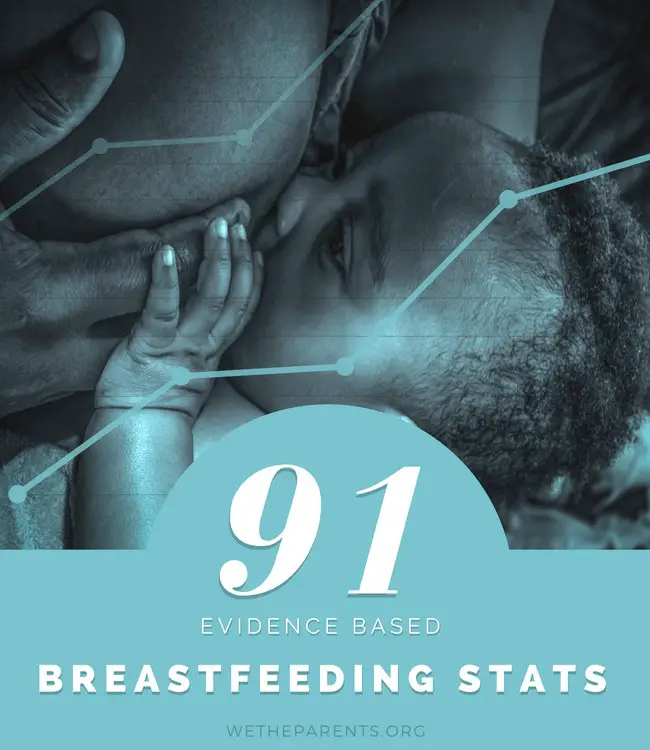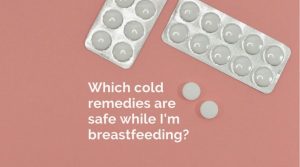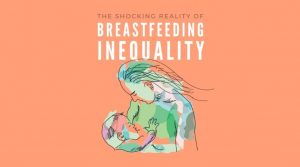This is the ultimate collection of 91 evidence-based breastfeeding statistics.
For breastfeeding advocates, it is a powerful resource providing compelling facts at your fingertips.
For everyone else (skeptics included), the following data demonstrates exactly why breastfeeding and human milk is considered the “normative standards” for infant feeding and nutrition.
This is backed up by the World Health Organization, UNICEF, and the American Academy of Pediatrics.
Given the documented short- and long-term medical and neurodevelopmental advantages of breastfeeding, infant nutrition should be considered a public health issue and not only a lifestyle choice. (AAP)
Each statistic is sourced from credible peer-reviewed journals or other notable authorities. These are noted alongside each stat so that you can verify the data and where it comes from.
Recommended practice
- 1 hour – Ideally, infants should be breastfed within one hour of birth
SOURCE: UNICEF
URL: data.unicef.org/topic/nutrition/infant-and-young-child-feeding - 6 months – Mothers are advised to exclusively breastfeeding for the first six months
SOURCE: The American Academy of Pediatrics
URL: pediatrics.aappublications.org/content/129/3/e827 - 1 year – Mothers are advised by the AAP to continue breastfeeding for at least a year and beyond for as long as mutually desired by mother and child
SOURCE: The American Academy of Pediatrics
URL: pediatrics.aappublications.org/content/129/3/e827 - 2 years – The WHO and UNICEF go further than the AAP and recommend continued breastfeeding for the first two years and beyond for as long as mutually desired by mother and child
SOURCE: UNICEF
URL: data.unicef.org/topic/nutrition/infant-and-young-child-feeding - 8 to 12 times – Infants should normally be breastfed 8 to 12 times per day
SOURCE: The American Academy of Pediatrics
URL: pediatrics.aappublications.org/content/129/3/e827 - 3 to 4 weeks – Pacifiers should not be offered to infants any earlier than 3 to 4 weeks (unless there is a medical reason to do so)
SOURCE: The American Academy of Pediatrics
URL: pediatrics.aappublications.org/content/129/3/e827
Breastfeeding rates by state and country
- 79% of US moms initiate breastfeeding
SOURCE: Office of Disease Prevention and Health Promotion (ODPHP)
URL: healthypeople.gov/2020/data-search/Search-the-Data?nid=4859 - 19% of US moms exclusively breastfeed for 6 months
SOURCE: Office of Disease Prevention and Health Promotion (ODPHP)
URL: healthypeople.gov/2020/data-search/Search-the-Data#objid=4863 - 26% of US moms are doing any breastfeeding at 1 year
SOURCE: Office of Disease Prevention and Health Promotion (ODPHP)
URL: healthypeople.gov/2020/data-search/Search-the-Data#objid=4861 - 19% of US babies are given formula within 2 days
SOURCE: Office of Disease Prevention and Health Promotion (ODPHP)
URL: healthypeople.gov/2020/data-search/Search-the-Data#objid=4865 - 40% – Globally, only 40% of infants under six months of age are exclusively breastfed
SOURCE: World Health Organization
URL: who.int/news-room/facts-in-pictures/detail/breastfeeding - US Breastfeeding Rates (lowest and highest by state)
- US Exclusive to 6-months Breastfeeding Rates (lowest and highest by state)
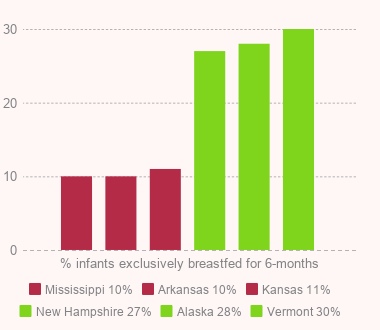
SOURCE: Office of Disease Prevention and Health Promotion (ODPHP)
URL: healthypeople.gov/2020/data-search/Search-the-Data#objid=4863 - US Any Breastfeeding at 1-Year Rates (lowest and highest by state)
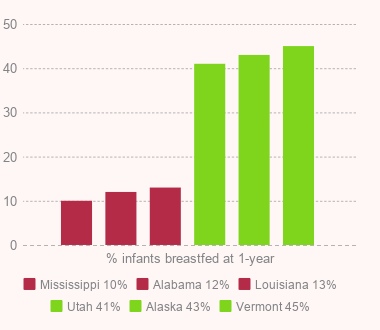
SOURCE: Office of Disease Prevention and Health Promotion (ODPHP)
URL: healthypeople.gov/2020/data-search/Search-the-Data#objid=4861 - US Breastfeeding Rates by Age
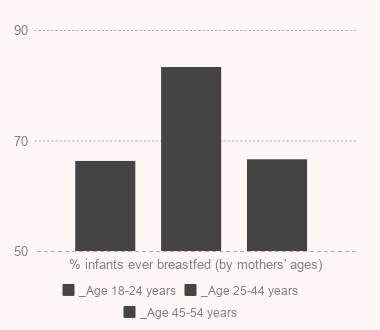
SOURCE: Office of Disease Prevention and Health Promotion (ODPHP)
URL: healthypeople.gov/2020/data-search/Search-the-Data#objid=4859 - US Breastfeeding Rates by Education
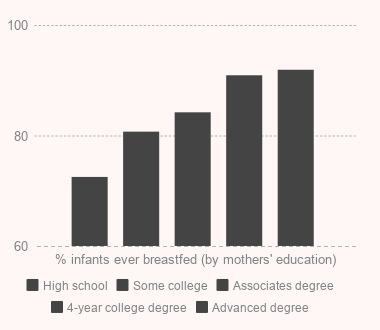
SOURCE: Office of Disease Prevention and Health Promotion (ODPHP)
URL: healthypeople.gov/2020/data-search/Search-the-Data#objid=4859 - US Breastfeeding Rates by Income
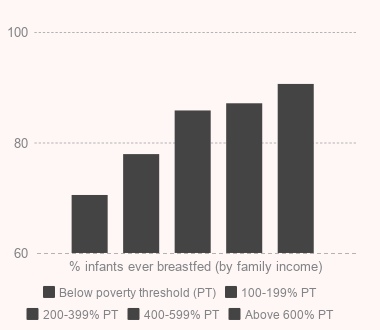
SOURCE: Office of Disease Prevention and Health Promotion (ODPHP)
URL: healthypeople.gov/2020/data-search/Search-the-Data#objid=4859 - Globally Breastfeeding Rate (any)
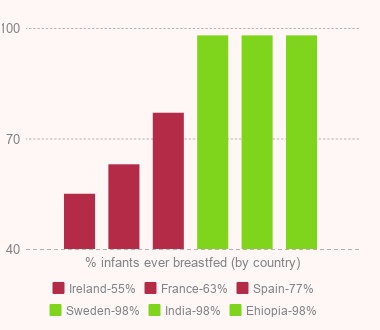
SOURCE: UNICEF
URL: data.unicef.org/topic/nutrition/infant-and-young-child-feeding/ - Globally Breastfeeding Rate (at 1 year)
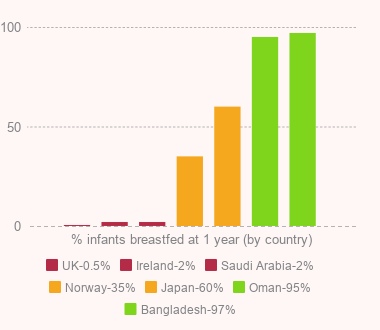
SOURCE: UNICEF
URL: data.unicef.org/topic/nutrition/infant-and-young-child-feeding/
Child health & intelligence benefits
- 36% – Breastfed babies have a 36% lower risk of SIDS (when nursed for longer than one month)
SOURCE: Ip S, Chung M, Raman G, et al., Tufts-New England Medical Center Evidence-based Practice Center. Breastfeeding and maternal and infant health outcomes in developed countries. Evid Rep Technol Assess (Full Rep). 2007;153(153):1–186 pmid:17764214PubMed
URL: ncbi.nlm.nih.gov/pubmed/17764214?dopt=Abstract - 63% – Exclusively breastfed babies have a 63% lower risk of hospitalization for an upper tract respiratory infection (when nursed for more than 6 months)
SOURCE: Duijts L, Jaddoe VW, Hofman A, Moll HA. Prolonged and exclusive breastfeeding reduces the risk of infectious diseases in infancy. Pediatrics. 2010;126(1)
URL: pediatrics.org/cgi/content/full/126/1/e18 - 72% – Exclusively breastfed babies have a 72% lower risk of hospitalization for a lower tract respiratory infection (when nursed for more than 4 months)
SOURCE: Ip S, Chung M, Raman G, et al., Tufts-New England Medical Center Evidence-based Practice Center. Breastfeeding and maternal and infant health outcomes in developed countries. Evid Rep Technol Assess (Full Rep). 2007;153(153):1–186 pmid:17764214PubMed
URL: ncbi.nlm.nih.gov/pubmed/17764214?dopt=Abstract - 40% – Breastfed babies have a 40% lower risk of developing asthma than formula fed babies (where there is a family history of Asthma)
SOURCE: Ip S, Chung M, Raman G, et al., Tufts-New England Medical Center Evidence-based Practice Center. Breastfeeding and maternal and infant health outcomes in developed countries. Evid Rep Technol Assess (Full Rep). 2007;153(153):1–186 pmid:17764214PubMed
URL: ncbi.nlm.nih.gov/pubmed/17764214?dopt=Abstract - 64% – Breastfed babies have a 64% lower risk of Gastroenteritis
SOURCE: Ip S, Chung M, Raman G, et al., Tufts-New England Medical Center Evidence-based Practice Center. Breastfeeding and maternal and infant health outcomes in developed countries. Evid Rep Technol Assess (Full Rep). 2007;153(153):1–186 pmid:17764214PubMed - 63% – Exclusively breastfed have a 63% lower risk of serious colds
SOURCE: Ip S, Chung M, Raman G, et al., Tufts-New England Medical Center Evidence-based Practice Center. Breastfeeding and maternal and infant health outcomes in developed countries. Evid Rep Technol Assess (Full Rep). 2007;153(153):1–186 pmid:17764214PubMed
URL: ncbi.nlm.nih.gov/pubmed/17764214?dopt=Abstract - 31% – Breastfed babies have a 31% lower risk of inflammatory bowel disease
SOURCE: Barclay AR, Russell RK, Wilson ML, Gilmour WH, Satsangi J, Wilson DC. Systematic review: the role of breastfeeding in the development of pediatric inflammatory bowel disease. J Pediatr. 2009;155(3):421–426pmid:19464699 - 24% – Breastfed babies have a 24% lower risk of obesity
SOURCE: Ip S, Chung M, Raman G, et al., Tufts-New England Medical Center Evidence-based Practice Center. Breastfeeding and maternal and infant health outcomes in developed countries. Evid Rep Technol Assess (Full Rep). 2007;153(153):1–186 pmid:17764214PubMed
URL: ncbi.nlm.nih.gov/pubmed/17764214?dopt=Abstract - 52% – Breastfed babies have a 52% lower risk of developing celiac disease (if breastfed at the time of gluten exposure)
SOURCE: Akobeng AK, Ramanan AV, Buchan I, Heller RF. Effect of breast feeding on risk of coeliac disease: a systematic review and meta-analysis of observational studies. Arch Dis Child. 2006;91(1):39–43pmid:16287899 - 30% – Exclusively breastfed babies have a 30% lower risk of type 1 diabetes (when nursed for longer than 3 months)
SOURCE: Ip S, Chung M, Raman G, et al., Tufts-New England Medical Center Evidence-based Practice Center. Breastfeeding and maternal and infant health outcomes in developed countries. Evid Rep Technol Assess (Full Rep). 2007;153(153):1–186 pmid:17764214PubMed
URL: ncbi.nlm.nih.gov/pubmed/17764214?dopt=Abstract - 40% – Breastfed babies have a 40% lower risk of type 2 diabetes
SOURCE: Ip S, Chung M, Raman G, et al., Tufts-New England Medical Center Evidence-based Practice Center. Breastfeeding and maternal and infant health outcomes in developed countries. Evid Rep Technol Assess (Full Rep). 2007;153(153):1–186 pmid:17764214PubMed
URL: ncbi.nlm.nih.gov/pubmed/17764214?dopt=Abstract - 74% – The severity of RSV bronchiolitis is reduced by 74% in infants who breastfed exclusively for 4 months
SOURCE: Nishimura T, Suzue J, Kaji H. Breastfeeding reduces the severity of respiratory syncytial virus infection among young infants: a multi-center prospective study. Pediatr Int. 2009;51(6):812–816 pmid:19419530 - 20% – Breastfed babies have a 20% lower risk of (acute lymphocytic) leukemia (when nursed for longer than 6 months)
SOURCE: Rudant J, Orsi L, Menegaux F, et al. Childhood acute leukemia, early common infections, and allergy: The ESCALE Study. Am J Epidemiol. 2010;172(9):1015–1027 pmid:20807738 - 72% of hospital admissions for diarrhea preventable by breastfeeding
SOURCE: The Lancet
URL: thelancet.com/journals/lancet/article/PIIS0140-6736(15)01024-7/fulltext - 3.4 points – Increase in IQ associated with children being breastfed
SOURCE: The Lancet
URL: thelancet.com/journals/lancet/article/PIIS0140-6736(15)01024-7/fulltext
Mother health benefits
- 10% – Women who breastfeed have a 10% lower risk of cardiovascular disease (if they have had a cumulative lifetime duration of lactation greater than 12 months
SOURCE: Schwarz, Eleanor Bimla et al. “Duration of Lactation and Risk Factors for Maternal Cardiovascular Disease.” Obstetrics and gynecology 113.5 (2009): 974–982. PMC. Web. 25 July 2018.
URL: ncbi.nlm.nih.gov/pmc/articles/PMC2714700/ - 4.3% – Women who breastfeed have a 4.3% lower risk of invasive breast cancer for every 12-months of cumulative lifetime breastfeeding
SOURCE: The Lancet
URL: thelancet.com/journals/lancet/article/PIIS0140-6736(15)01024-7/fulltext - 30% – Women who breastfeed for long periods have a 30% lower risk of ovarian cancer
SOURCE: The Lancet
URL: thelancet.com/journals/lancet/article/PIIS0140-6736(15)01024-7/fulltext - 15% – each year a mother breastfeeds she reduces her risk of type 2 diabetes by 15% For
SOURCE: Much, Daniela et al. “Beneficial Effects of Breastfeeding in Women with Gestational Diabetes Mellitus.” Molecular Metabolism 3.3 (2014): 284–292. PMC. Web. 25 July 2018.
URL: ncbi.nlm.nih.gov/pmc/articles/PMC3986583/
Saving lives
Each year, a large number of deaths would be prevented by adopting optimal breastfeeding practices.
Globally:
- 823 000 child deaths prevented
SOURCE: World Health Organization
URL: who.int/news-room/facts-in-pictures/detail/breastfeeding - 20 000 maternal deaths caused by breast cancer prevented
SOURCE: The Lancet
URL: thelancet.com/journals/lancet/article/PIIS0140-6736(15)01044-2/fulltext - 597 – For every 597 women who optimally breastfeed, one maternal or child death is prevented
SOURCE: Bartrick MC et al “Suboptimal breastfeeding in the United States: Maternal and pediatric health outcomes and costs” PMID: 27647492
URL: ncbi.nlm.nih.gov/pubmed/27647492
In the USA:
- 2605 maternal deaths prevented
SOURCE: Bartrick MC et al “Suboptimal breastfeeding in the United States: Maternal and pediatric health outcomes and costs” PMID: 27647492
URL: ncbi.nlm.nih.gov/pubmed/27647492 - 986 maternal deaths from heart disease prevented
SOURCE: Bartrick MC et al “Suboptimal breastfeeding in the United States: Maternal and pediatric health outcomes and costs” PMID: 27647492
URL: ncbi.nlm.nih.gov/pubmed/27647492 - 838 maternal deaths from breast cancer prevented
SOURCE: Bartrick MC et al “Suboptimal breastfeeding in the United States: Maternal and pediatric health outcomes and costs” PMID: 27647492
URL: ncbi.nlm.nih.gov/pubmed/27647492 - 473 maternal deaths from diabetes prevented
SOURCE: Bartrick MC et al “Suboptimal breastfeeding in the United States: Maternal and pediatric health outcomes and costs” PMID: 27647492
URL: ncbi.nlm.nih.gov/pubmed/27647492 - 735 child death prevents
SOURCE: Bartrick MC et al “Suboptimal breastfeeding in the United States: Maternal and pediatric health outcomes and costs” PMID: 27647492
URL: ncbi.nlm.nih.gov/pubmed/27647492 - 492 child SIDS deaths prevented
SOURCE: Bartrick MC et al “Suboptimal breastfeeding in the United States: Maternal and pediatric health outcomes and costs” PMID: 27647492
URL: ncbi.nlm.nih.gov/pubmed/27647492
Economy & Environment
- $302 billion – Estimated global economic loss each year from cognitive deficits (ie, people not reaching their cognitive potential and thereby contributing less to the economy). This money would be saved if every infant was breastfed until at least 6-months
SOURCE: The Lancet
URL: thelancet.com/action/showFullTableImage?tableId=tbl2&pii=S0140673615010442 - $2·45 billion would be saved in the US each year through reduced treatment costs of childhood disorders if 90% of women were to exclusively breastfeed up to 6 months and continue to breastfeed up to 1 or 2 years
SOURCE: The Lancet
URL: thelancet.com/journals/lancet/article/PIIS0140-6736(15)01044-2/fulltext - $2528 per person is spent on formula in high-income countries
SOURCE: The Lancet
URL: thelancet.com/journals/lancet/article/PIIS0140-6736(15)01044-2/fulltext - $11.07 million was invested into advertising baby formula in the US in 2014
SOURCE: Statista
URL: statista.com/statistics/632044/infant-formula-ad-spend-usa/ - $62.5 billion is the forecast for the baby formula market by 2020
SOURCE: Statista
URL: statista.com/statistics/719436/global-market-size-baby-formula - 550 million cans, 86 000 tons of metal, and 364 000 tons of paper, annually used to package formula, end up in landfills
SOURCE: The Lancet
URL: thelancet.com/journals/lancet/article/PIIS0140-6736(15)01044-2/fulltext
Hospital services & Breastfeeding support
In US hospitals:
- 24% of US-born babies are delivered in “Baby-Friendly” designated hospitals or birthing centers. (These are maternity facilities that have successfully implemented the Ten Steps to Successful Breastfeeding.)
SOURCE: Baby Friendly USA
URL: babyfriendlyusa.org/newsviews-pages/celebrating-500 - 1 in 6 hospitals and birthing centers in the US are “Baby-Friendly” designated
SOURCE: Baby Friendly USA
URL: babyfriendlyusa.org/newsviews-pages/celebrating-500 - 58% of hospitals erroneously advised mothers to limit suckling at the breast to a specified length of time (a practice documented to lower breastfeeding rates and duration)
SOURCE: Dewey KG, Nommsen-Rivers LA, Heinig MJ, Cohen RJ. Risk factors for suboptimal infant breastfeeding behavior, delayed onset of lactation, and excess neonatal weight loss. Pediatrics. 2003;112(3 pt 1):607–619 pmid:12949292
URL: ncbi.nlm.nih.gov/pubmed/12949292 - 41% of hospitals gave pacifiers to more than some of their newborns (a practice documented to lower breastfeeding rates and duration)
SOURCE: Dewey KG, Nommsen-Rivers LA, Heinig MJ, Cohen RJ. Risk factors for suboptimal infant breastfeeding behavior, delayed onset of lactation, and excess neonatal weight loss. Pediatrics. 2003;112(3 pt 1):607–619 pmid:12949292
URL: ncbi.nlm.nih.gov/pubmed/12949292 - 67% of US mothers receive free formula samples from their hospital or birthing center. (Such gifts are associated with shorter breastfeeding duration)
SOURCE: The Lancet
URL: thelancet.com/journals/lancet/article/PIIS0140-6736(15)01044-2/fulltext - 24% of maternity services provide supplements of commercial infant formula as a general practice within the first 48 hours after birth
SOURCE: The American Academy of Pediatrics
URL: pediatrics.aappublications.org/content/129/3/e827 - 27% of hospitals support breastfeeding mothers after discharge
SOURCE: The American Academy of Pediatrics
URL: pediatrics.aappublications.org/content/129/3/e827
At work and in the community:
- 86% – Timely breastfeeding initiation is increased by 86% where mothers receive community-based interventions, including group counseling or education
SOURCE: The Lancet
URL: helancet.com/journals/lancet/article/PIIS0140-6736(15)01044-2/fulltext - 20% – Exclusive breastfeeding is increased by 20% where mothers receive community-based interventions, including group counseling or education
SOURCE: The Lancet
URL: thelancet.com/journals/lancet/article/PIIS0140-6736(15)01044-2/fulltext - 8.9% – Increase in exclusive breastfeeding when mothers receive paid-break guarantees for at least 6 months
SOURCE: Heymann, J, Raub, A, and Earle, A. Breastfeeding policy: a globally comparative analysis. Bull World Health Organ. 2013; 91: 398–406
URL: ncbi.nlm.nih.gov/pubmed/24052676 - 25% – Breastfeeding at 6 months is increased by 25% where working mothers have access to lactation rooms and receive breaks to pump
SOURCE: Dabritz, HA, Hinton, BG, and Babb, J. Evaluation of lactation support in the workplace or school environment on 6-month breastfeeding outcomes in Yolo County, California. J Hum Lact. 2009; 25: 182–193
URL: ncbi.nlm.nih.gov/pubmed/19088250 - 23% of the world’s countries meet or exceed the recommendation of 18 weeks maternity protection
SOURCE: The Lancet
URL: thelancet.com/journals/lancet/article/PIIS0140-6736(15)01044-2/fulltext - 3:1 – For every $1 invested in creating and supporting a lactation support program (including a designated pump site that guarantees privacy, availability of refrigeration and a hand-washing facility, and appropriate mother break time) there is a $2 to $3 dollar return
SOURCE: The American Academy of Pediatrics
URL: pediatrics.aappublications.org/content/129/3/e827
Attitudes & Perceptions
- 60% of mothers do not breastfeed for as long as they intend to
SOURCE: Centers for Disease Control and Prevention
URL: cdc.gov/breastfeeding/data/facts.html - 50% of mothers cite insufficient milk supply as their reason for stopping breastfeeding
SOURCE: Centers for Disease Control and Prevention
URL: cdc.gov/breastfeeding/data/facts.html - 45% of adults surveyed believe a breastfeeding mother has to give up too many habits of her lifestyle
SOURCE: Centers for Disease Control and Prevention
URL: cdc.gov/breastfeeding/data/facts.html - 31% of mothers surveyed thought that babies ought to be fed cereal or baby food by age 3 months
SOURCE: Centers for Disease Control and Prevention
URL: cdc.gov/breastfeeding/data/facts.html - 31% of mothers surveyed said that 1-year-olds should not be breastfed
SOURCE: Centers for Disease Control and Prevention
URL: cdc.gov/breastfeeding/data/facts.html - 27% of mothers surveyed felt breastfeeding in public was embarrassing
SOURCE: Centers for Disease Control and Prevention
URL: cdc.gov/breastfeeding/data/facts.html - 58% – Only 58% of Americans surveyed said they were comfortable when mothers breastfeed their babies near them in a public place
SOURCE: Centers for Disease Control and Prevention
URL: cdc.gov/breastfeeding/data/facts.html - 13% of adults surveyed believed that mothers should not have the right to breastfeed in public
SOURCE: Centers for Disease Control and Prevention
URL: cdc.gov/breastfeeding/data/facts.html - 70% of adults surveyed felt there should be paid maternity leave to workers
SOURCE: Centers for Disease Control and Prevention
URL: cdc.gov/breastfeeding/data/facts.html
Weaning
- 2 to 4 years is the typical age of weaning in most traditional societies
SOURCE: Dettwyler, KA. A time to wean: the hominid blueprint for the natural age of weaning in modern human populations. in: PS Macadam, KA Dettwyller (Eds.) Breastfeeding: biocultural perspectives. Walter de Gruyter, Inc, New York; 1995: 39–73 - 3 to 4 years is the typical age children self-wean in societies where children are allowed to nurse “as long as they want”
SOURCE: Katherine Dettwyler, PhD, Department of Anthropology, Texas A and M University
URL: iamnotthebabysitter.com/the-natural-human-weaning-age/ - 2.5 to 7 years is the natural age of human weaning based on the patterns of nonhuman primates
SOURCE: Patricia Stuart-Macadam “Breastfeeding, Bicultural Perspectives”
URL: taylorfrancis.com/books/9781351530743/chapters/10.4324%2F9781315081984-8 - 7 years was not an uncommon age of weaning among Inuits recorded in a 1953 survey of various traditional tribes
SOURCE: Beyond Toddlerhood: The Breastfeeding Relationship Continues by Priscilla Young Colletto
URL: naturalchild.org/guest/priscilla_colletto.html
Milk sharing
- 654 is the estimated number of milk banks worldwide in 2016
SOURCE: Haiden et al 2016
URL: 2018.worldneonatology.com/wp-content/uploads/2017/07/INAC-Milk-Banking-World-Wide-Jean-Charles-Picaud.pdf - 217 is the number of milk banks in Brazil, by far the most in the world
SOURCE: International Milk Genomics Consortium
URL: milkgenomics.org/article/milk-banks-around-the-world/ - 166 848 is the number of Brazilian women donated breast milk in 2014
SOURCE: International Milk Genomics Consortium
URL: milkgenomics.org/article/milk-banks-around-the-world/ - $3 to $5 per ounce is the cost of human donor milk from milk banks
SOURCE: St-Onge, Maude, Shahnaz Chaudhry, and Gideon Koren. “Donated Breast Milk Stored in Banks versus Breast Milk Purchased Online.” Canadian Family Physician 61.2 (2015): 143–146. Print.
URL: ncbi.nlm.nih.gov/pmc/articles/PMC4325861/ - $60 to $100 per day is the cost for an 3.6-kg baby to consume 20 ounces of milk per day purchased from a milk bank
SOURCE: St-Onge, Maude, Shahnaz Chaudhry, and Gideon Koren. “Donated Breast Milk Stored in Banks versus Breast Milk Purchased Online.” Canadian Family Physician 61.2 (2015): 143–146. Print.
URL: ncbi.nlm.nih.gov/pmc/articles/PMC4325861/ - $0.50 to $2 per ounce is the lower-end cost of human donor milk from milk-sharing websites
SOURCE: St-Onge, Maude, Shahnaz Chaudhry, and Gideon Koren. “Donated Breast Milk Stored in Banks versus Breast Milk Purchased Online.” Canadian Family Physician 61.2 (2015): 143–146. Print.
URL: ncbi.nlm.nih.gov/pmc/articles/PMC4325861/ - $10 to $40 per day is the lower-end cost for an 3.6-kg baby to consume 20 ounces of milk per day purchased from a milk-sharing website
SOURCE: St-Onge, Maude, Shahnaz Chaudhry, and Gideon Koren. “Donated Breast Milk Stored in Banks versus Breast Milk Purchased Online.” Canadian Family Physician 61.2 (2015): 143–146. Print.
URL: ncbi.nlm.nih.gov/pmc/articles/PMC4325861/ - 77% – Study of Ohio women found that 77% new about milk-sharing, 25% had considered it, and 4% had shared-milk
SOURCE: Keim SA et al, “Breastmilk sharing: awareness and participation among women in the Moms2Moms Study”
URL: ncbi.nlm.nih.gov/pubmed/25007386 - 96.1% – Study of women who milk-shared found that 96.1% reported doing it face-to-face either with family members or at a local level with people they trusted
SOURCE: Palmquist A, Doehler K, “Human milk sharing practices in the U.S”
URL: ncbi.nlm.nih.gov/pubmed/26607304 - 54 000 – Estimated number of currently active members on Only the Breast, the world’s most popular milk-sharing website
SOURCE: Al Jazeera
URL: america.aljazeera.com/articles/2015/3/24/dangers-of-buying-human-breast-milk-online.html - 75% – Although anonymous milk-sharing with unscreened strangers is less common, it does happen. One study found 75% breast milk samples purchased online in this way exhibited high overall bacterial growth and frequent contamination with pathogenic bacteria, reflecting poor collection, storage, or shipping practices
SOURCE: Keim SA, “Microbial contamination of human milk purchased via the Internet.”
URL: ncbi.nlm.nih.gov/pubmed/24144714
Birth control
- 99% – Breastfeeding is 99% effective as a birth control method within the first six months of baby’s life (so long as the mother exclusively breastfeeds without pumping and has not yet had a period)
SOURCE: Association of Reproductive Health Professionals
URL: arhp.org/Publications-and-Resources/Patient-Resources/Fact-Sheets/Breastfeeding - 50% more births would be expected in developing countries where breastfeeding is high (if it were stopped)
SOURCE: The Lancet
URL: thelancet.com/journals/lancet/article/PIIS0140-6736(15)01024-7/fulltext

